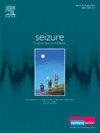意识受损患者的不自主运动:现象学和神经生理学评价的比较研究
IF 2.8
3区 医学
Q2 CLINICAL NEUROLOGY
引用次数: 0
摘要
意识受损患者的细微不自主运动可能提示非惊厥性癫痫持续状态(NCSE),但其诊断准确性尚不清楚。由于脑电图(EEG)并不总是可用的,临床医生经常依靠运动体征进行早期诊断。我们的目的是表征这些运动,并评估专家之间的解释一致性和诊断准确性。方法对2014 - 2019年98例疑似NCSE患者进行视频脑电图的回顾性观察研究。两名癫痫学家和两名运动障碍专家对不自主运动的视频样本进行了审查,他们对临床数据一无所知。从现象学上对运动进行分类,并将其分为癫痫性和非癫痫性。最终的NCSE诊断采用修改后的萨尔茨堡共识标准。计算判定者一致性和诊断指标。结果确诊病例37例(37.8%)。肌阵挛(43.3%)、震颤(26.8%)和阵挛(19.6%)是最常见的症状。NCSE组与非NCSE组在运动类型上无显著差异。评分者之间的一致性总体上是一般的(κ = 0.26),仅在震颤方面是中等的(κ = 0.577)。单纯基于影像的诊断敏感性和特异性分别为54.1%和68.9%。运动障碍专科医生的敏感性(68.2%)高于癫痫专科医生(敏感性42.3%,特异性77.5%),但特异性较低(62.2%)。结论单纯的运动现象并不能可靠地将NCSE与其他原因的意识受损区分开来。尽管使用频繁,但这些体征显示出有限的诊断准确性和较低的相互可靠性。视频脑电图仍然是必不可少的,未来的研究应该完善早期NCSE识别的临床工具。本文章由计算机程序翻译,如有差异,请以英文原文为准。
Involuntary movements in patients with impaired awareness: A comparative study of phenomenology and neurophysiological evaluation
Introduction
Subtle involuntary movements in patients with impaired awareness may suggest non-convulsive status epilepticus (NCSE), but their diagnostic accuracy is unclear. Since electroencephalography (EEG) is not always available, clinicians often rely on motor signs for early diagnosis. We aimed to characterize these movements and evaluate interrater agreement and diagnostic accuracy among specialists.
Methods
We conducted a retrospective observational study of 98 patients with suspected NCSE who underwent video-EEG between 2014 and 2019. Video samples of involuntary movements were reviewed by two epileptologists and two movement disorder specialists, blinded to clinical data. Movements were classified phenomenologically and categorized as epileptic or non-epileptic. Final NCSE diagnosis was determined using modified Salzburg Consensus Criteria. Interrater agreement and diagnostic metrics were calculated.
Results
NCSE was confirmed in 37 patients (37.8 %). Myoclonus (43.3 %), tremor (26.8 %), and clonus (19.6 %) were the most frequent phenomena. No significant differences in movement types were observed between NCSE and non-NCSE groups. Interrater agreement was fair overall (κ = 0.26), moderate only for tremor (κ = 0.577). Diagnostic sensitivity and specificity based on video alone were 54.1 % and 68.9 %, respectively. Movement disorder specialists were more sensitive (68.2 %) but less specific (62.2 %) than epileptologists (42.3 % sensitivity; 77.5 % specificity).
Conclusion
Motor phenomena alone do not reliably distinguish NCSE from other causes of impaired consciousness. Despite frequent use, these signs show limited diagnostic accuracy and low interrater reliability. Video-EEG remains essential, and future studies should refine clinical tools for early NCSE recognition.
求助全文
通过发布文献求助,成功后即可免费获取论文全文。
去求助
来源期刊

Seizure-European Journal of Epilepsy
医学-临床神经学
CiteScore
5.60
自引率
6.70%
发文量
231
审稿时长
34 days
期刊介绍:
Seizure - European Journal of Epilepsy is an international journal owned by Epilepsy Action (the largest member led epilepsy organisation in the UK). It provides a forum for papers on all topics related to epilepsy and seizure disorders.
 求助内容:
求助内容: 应助结果提醒方式:
应助结果提醒方式:


